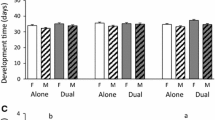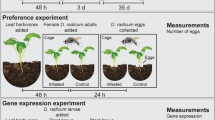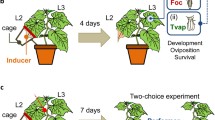Abstract
Recent work suggests that foliar- and root-feeding insects can interact in a novel plus-minus fashion. However, the effects of herbivores may be different at different densities. This paper describes two laboratory experiments investigating the effect of increasing insect density on plant performance and the host-plant mediated interaction between a leaf-mining fly and root-feeding chafer larvae. Above- and below-ground insect herbivory decreased plant performance. The effects of the root feeder were, for some parameters, different between the two densities of chafer larvae. Leaf mining significantly decreased the performance of the chafer larvae, while root herbivory was found to increase the pupal weight (related to fecundity) of the leaf miner. The effects of root herbivory suggest that the relationships between herbivore density and plant performance may be curved as the greater chafer density had no significant increased effect on the plants or foliar-feeding insects.
Similar content being viewed by others
References
Amino-Kano M. (1987) Pollutant/plant/pest interactions: Sulphur dioxide, winter cereals and the grain aphid,Sitobion avenae (F). PhD Thesis, University of London.
Arthur W. &Mitchell P. (1989) A revised scheme for the classification of population interactions.Oikos 56: 141–143.
Barrs H. D. (1968) Determination of water deficits in plant tissue. In:Water Deficits and Plant Growth, Vol. 1 (ed. T. T. Kozlowski), pp. 235–368. Academic Press, London.
Broodbank A. R. (1984) Seasonal patterns in the amino acid content of the grassHolcus mollis (L.) in relation to insect feeding. Diploma of membership of Imperial College, University of London.
Brown V. K. &Gange A. C. (1990) Insect herbivory below ground.Advances in Ecological Research 20: 1–58.
Chapin F. S. III (1991) Integrated response of plants to stress. A centralized system of physiological responses.Bioscience 41: 29–36.
Davidson R. L. (1979) Effects of root feeding on foliage yield. In:Proceedings of the 2nd Australasian Conference on Grassland Invertebrate Ecology (eds T. K. Crosby & R. F. Pottinger) pp. 117–120. Government Printer, Wellington.
French N. (1984) Chafer grubs. MAFF leaflet No. 235.
Gange A. C. &Brown V. K. (1989) Effects of root herbivory by an insect on a foliar-feeding species, mediated through changes in the host plant.Oecologia 81: 38–42.
Gange A. C., Brown V. K., Barlow G. S., Whitehouse D. M. &Moreton R. J. (1991) Spatial distribution of Garden chafer larvae in a golf tee.Journal of the Sports Turf Research Institute 67: 8–13.
Jones F. G. W. &Jones M. G. (1984)Pests of Field Crops, 3rd edn. Edward Arnold Ltd, London.
Kozon M. J. &Cowley D. W. (1980) Changes in carbohydrate levels in Red Kidney bean (Phaseolus vulgaris) exposed to sulphur dioxide.Journal of Experimental Botany 29: 1037–1043.
Ladd T. I. &Buriff C. R. (1979) Japanese beetle: Influence of larval feeding on bluegrass yields at two levels of soil moisture.Journal of Economic Entomology 72: 311–314.
Larsson S. (1989) Stressful times for the plant stress-insect performance hypothesis.Oikos 56: 277–283.
Masters G. J. (1992) Interactions between foliar- and root-feeding insects. PhD Thesis, University of London.
Masters G. J. &Brown V. K. (1992) Plant-mediated interactions between two spatially separated insects.Functional Ecology 6: 175–179.
Masters G. J., Brown V. K. &Gange A. C. (1993) Plant mediated interactions between above- and below-ground insect herbivores.Oikos 66: 148–151.
Mattson W. J. &Haack R. A. (1987) The role of drought stress in provoking outbreaks of phytophagous insects. In:Insect Outbreaks (eds P. Barbosa & J. C. Schultz) pp. 365–407. Academic Press, New York.
McQuate G. T. &Connor E. F. (1990) Insect responses to plant water deficits. II. Effect of water deficits in soybean plants on the growth and survival of Mexican bean beetle larvae.Ecological Entomology 15: 433–445.
Mihaliak C. A. &Lincoln D. E. (1989) Plant biomass partitioning and chemical defence: Response to defoliation and nitrate limitation.Oecologia 80: 122–126.
Milne A. (1956) Biology and ecology of the garden chafer,Phyllopertha horticola L. II. The cycle from egg to adult in the field.Bulletin of Entomological Research 47: 23–42.
Moran N. A. &Whitham T. G. (1990) Interspecific competition between root-feeding and leaf galling aphids mediated by host plant resistance.Ecology 71: 1050–1058.
Nowak R. S. &Caldwell M. M. (1984) A test of compensatory photosynthesis in the field: Implications for herbivory tolerance.Oecologia 61: 311–318.
Quiring D. T. &McNeil J. N. (1984) Influence of intraspecific larval competition and mating on the longevity and reproductive performance of females of the leaf minerAgromyza frontella (Rondani) (Diptera: Agromyzidae).Canadian Journal of Zoology 69: 2197–2200.
Radford P. J. (1967) Growth analysis formulae—their use and abuse.Crop Science 7: 171–175.
Ridsdill Smith T. J. (1977) Effects of root-feeding by scarabaeid larvae on growth of perennial ryegrass plants.Journal of Applied Ecology 14: 73–80.
Ryle G. J. A. &Powell C. E. (1975) Defoliation and regrowth in the graminaceous plant: The role of current assimilate.Annals of Botany 39: 297–310.
Scriber J. M. (1977) Limiting effect of low leaf-water content on the nitrogen utilization, energy budget, and larval growth ofHyalophora cecropia (Lepidoptera: Saturniidae).Oecologia 28: 269–287.
Spencer K. A. (1972)Diptera, Agromyzidae. Handbooks for the Identification of British Insects Vol. X, part 5(g). Royal Entomological Society, E. W. Classey Ltd, Middlesex, UK.
van Emden H. F. &Bashford M. (1969) A comparison of the reproduction ofBrevicoryne brassicae andMyzus persicae in relation to soluble nitrogen concentration and leaf age (leaf position) in the Brussels Sprout plant.Entomologia Experimentalis et Applicata 12: 351–364.
Varley J. A. (1966) Automatic methods for the determination of nitrogen, phosphorous and potassium in plant material.Journal of the Chemical Society 91: 119–126.
White T. C. R. (1984) The abundance of invertebrate herbivores in relation to the availability of nitrogen in stressed food plants.Oecologia 63: 90–105.
Zar J. H. (1984)Biostatistical Analysis, 2nd edn. Prentice Hall, New Jersey.
Author information
Authors and Affiliations
About this article
Cite this article
Masters, G.J. The effect of herbivore density on host plant mediated interactions between two insects. Ecol. Res. 10, 125–133 (1995). https://doi.org/10.1007/BF02347934
Received:
Accepted:
Issue Date:
DOI: https://doi.org/10.1007/BF02347934




